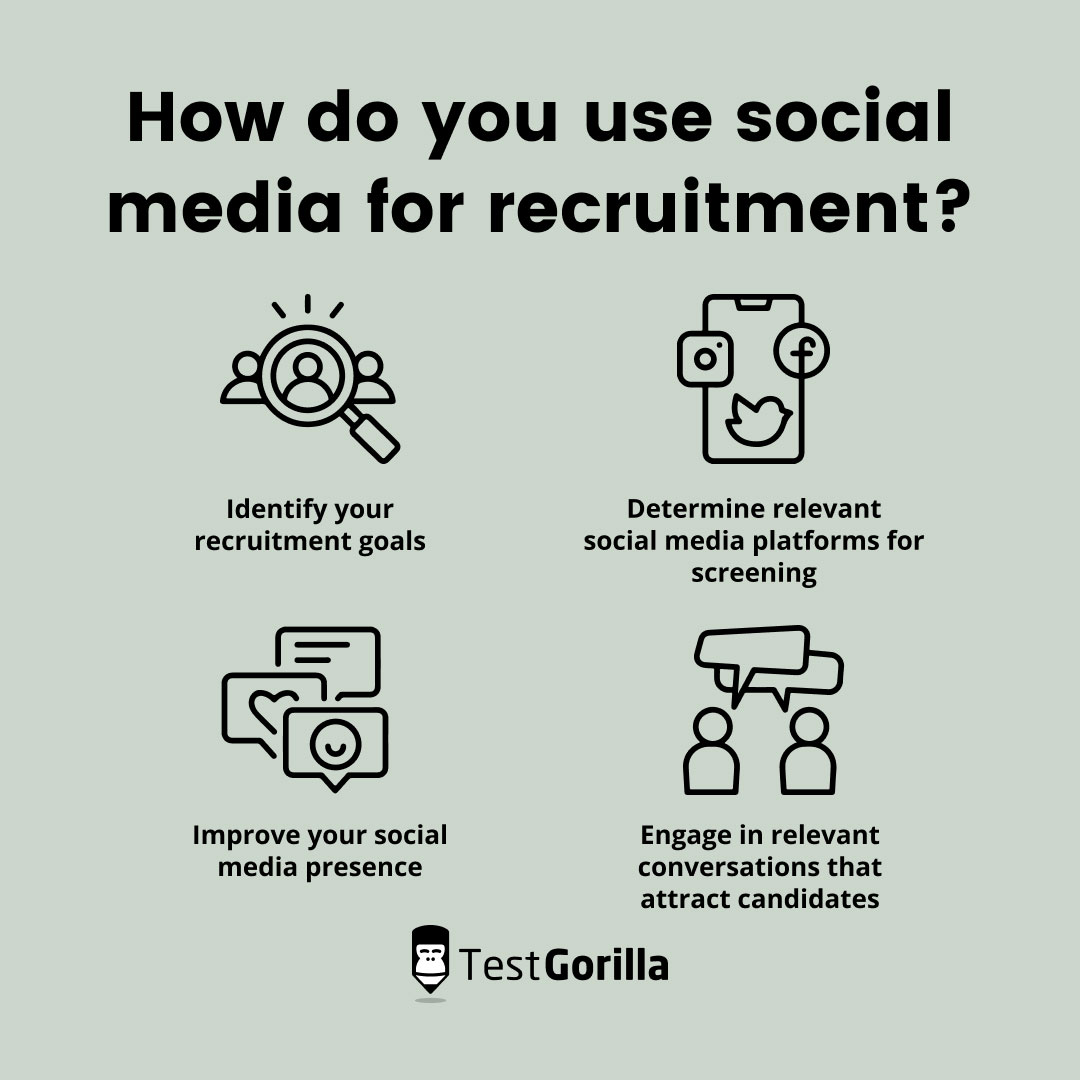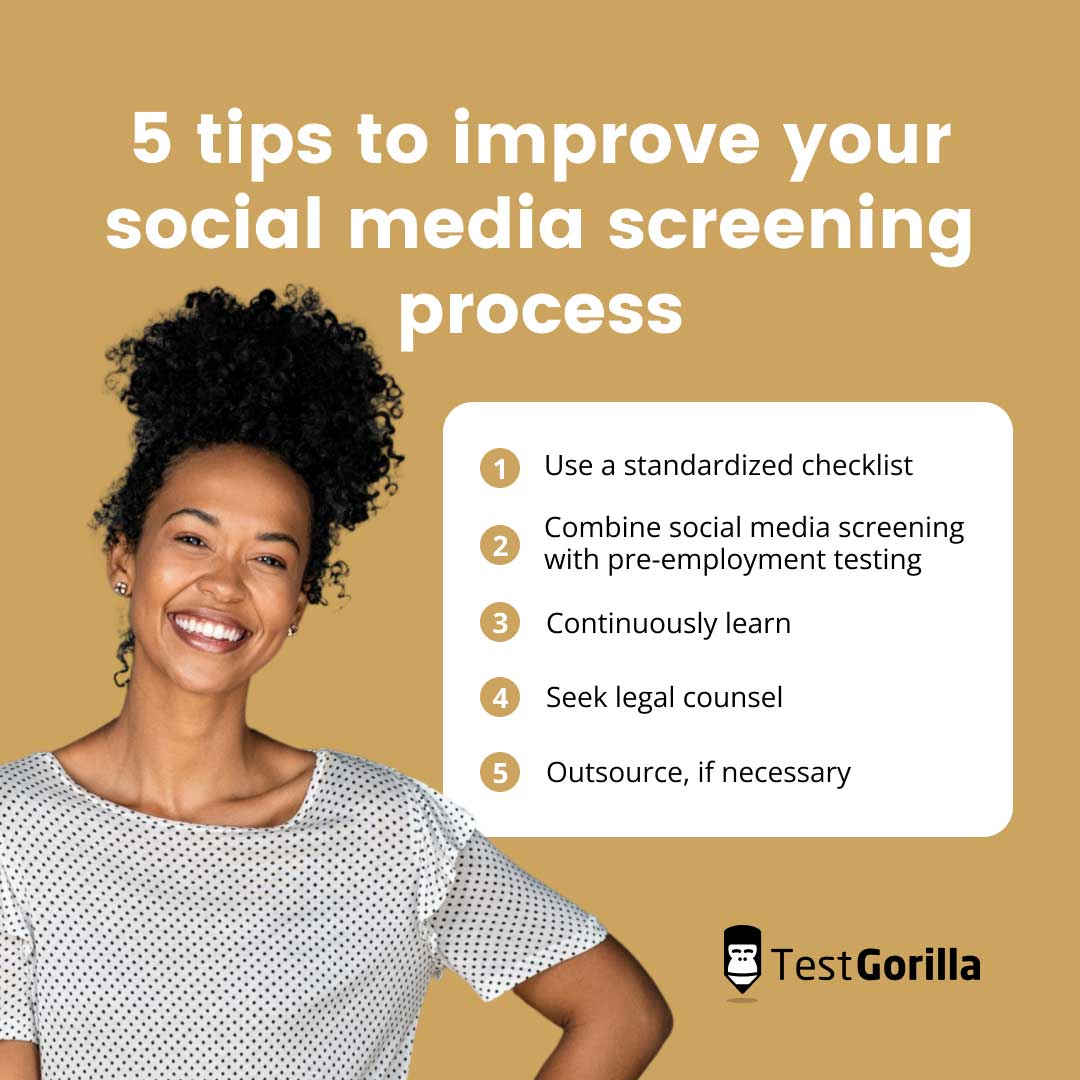Social media has become integral to our lives, blurring the lines between personal and professional spheres. As a result, employers are turning to social media to find top talent and obtain a more detailed picture of candidates – enhancing the applicant screening process.
Social media screening enables employers to pick up on any red flags early in the process, such as discriminatory behavior or intolerance, which is highly detrimental to a healthy workplace culture. It also acts as a preventative measure against the costly mistake of poor hiring decisions, avoiding disruption to team dynamics and reduced productivity.
This guide explores social media screening, why it's essential in recruitment, and offers tips to maximize its benefits.
Table of contents
- What is social media screening?
- Why your business needs a social media screening policy
- How do you use social media for recruitment?
- The benefits of effective social media screening for recruitment
- Disadvantages of social media screening in recruitment
- Six social media recruitment strategies for your next campaign
- 5 tips to improve your social media screening process
- How TestGorilla can aid your social media screening process
What is social media screening?
Social media screening is the process of researching and analyzing your candidate's online presence to gather information about them. Social platforms include LinkedIn, Facebook, X (formerly Twitter), Instagram, and others.
This review method can help you understand your candidate's character, preferences, and behavior, as well as their education, qualifications, and employment history. Social media screening also enables employers to identify potential red flags, such as blatant misalignment with company values.
Why your business needs a social media screening policy
As social media screening becomes more commonplace in the recruitment process, your business needs to create clear policies and guidelines for this practice. A well-defined social media screening policy serves several purposes:
Consistency: Team members involved in the screening process can adhere to set criteria and procedures.
Legal compliance: A strict policy helps your organization stay compliant with relevant laws and regulations, reducing the risk of legal challenges.
Protects privacy: Your social media screening policy outlines how you will respect your candidates' privacy and only use publicly available information.
Transparency: Informing candidates of your policy promotes clear communication and company expectations.
Mitigates bias: Clear guidelines help reduce unconscious bias by focusing on job-related criteria and avoiding subjective judgments.
The best insights on HR and recruitment, delivered to your inbox.
Biweekly updates. No spam. Unsubscribe any time.
How do you use social media for recruitment?
Social media screening allows you to assess candidates and shortlist those who appear to align with the role and your company’s culture. Below, we outline the steps to take when using social media for recruitment.
1. Identify your recruitment goals
Determine the current and future needs of the company with department leads and stakeholders. What positions need to be filled? Are there any skills gaps in the existing team?
Identify the specific roles or skill sets crucial for the company's growth and success and set benchmarks for the quality of hire, focusing on finding candidates who are qualified and align with the company culture.
2. Determine relevant social media platforms for screening
Pinpoint the social media platforms your candidates typically use and select those platforms for screening.
To do this, start by understanding the demographics and preferences of your ideal candidates, as different social media platforms attract different user demographics. Consider factors like age, profession, location, and industry.
Some professions have a stronger presence on specific platforms. For example, LinkedIn is popular among those in technical fields, while platforms like Instagram or Pinterest may be more appropriate for creative individuals.
3. Improve your social media presence
Update your company's social media profiles with relevant information, including a clear description of your organization's mission and values. Showcase your company culture by sharing content, such as employee testimonials, behind-the-scenes photos, and stories that reflect your workplace environment.
To make more of an impact, establish your organization as a thought leader in your field. Share informative and industry-specific content, including articles, reports, and trends, and respond quickly to comments and messages from followers.
4. Engage in relevant conversations that attract candidates
Stay informed about industry trends, discussions, and relevant hashtags on social platforms by following industry publications, influencers, and thought leaders.
Take part in active conversations by commenting on posts, sharing your perspective, and offering valuable information. Pose relevant questions to your network and industry groups, and encourage discussions that enable professionals to share their expertise and experiences.
The benefits of effective social media screening for recruitment
Fast and affordable: Social media screening is low-cost if conducted internally by your hiring team. Internal screening policies and structured search criteria can help to expedite the process, keeping your team focused.
Provides a holistic view of your candidate: Social media can show a different side of a candidate beyond what’s presented in their resume or during an interview. You can glean additional data by observing a candidate's personality, interests, and online behavior.
Verifies qualifications: While social media screening doesn’t replace formal background or reference checks, it can help verify specific qualifications and professional affiliations to an extent, such as education, degrees, and professional memberships.
Reduces the risk of mis-hires: Identifying potential red flags, such as discriminatory comments, intolerance, violence, and unprofessional behavior early in the process can help you avoid hiring the wrong candidate.
Enhances diversity and inclusion: Social media screening can help identify candidates from diverse backgrounds, contributing to more inclusive hiring practices.
Disadvantages of social media screening in recruitment
Privacy concerns: Candidates may perceive social media screening as an intrusive violation of their privacy, blurring the lines of personal and professional life.
Legal risks: Biased hiring decisions made from information obtained from social media can lead to discrimination claims.
Unconscious bias: Without strict policies, social media screening risks affinity and stereotype bias.
Incomplete information: Social media screening can lead to inaccurate and unreliable assessments. For example, selective or curated profiles might not accurately represent a candidate.
Six social media recruitment strategies for your next campaign
1. Use content that emphasizes company culture
Create and share informative content that showcases positive company culture and attracts potential candidates. For example, post teamwork content and share employee successes online.
2. Encourage employee advocacy
Potential candidates want to hear from current employees. Encourage your team to share job openings and promote your organization on their personal social media accounts, but don’t make it mandatory.
3. Use targeted advertising
For strategic social media recruitment, post targeted ads to reach quality candidates with specific qualifications, skills, and interests. This greatly reduces application processing times, even eliminating the application stage completely.
4. Network in relevant groups
Network within industry-specific groups and communities through trends and hashtags, such as #recruitment or #graphicdesign. Engage in the appropriate platform that attracts the candidates you’re looking for.
5. Emphasize employer branding
Cultivate a strong employer brand by highlighting your company's unique selling points and values. Show your company’s commitment to work-life balance and inclusion on your chosen social platform through posts about employee benefits and diversity. You can also curate content that displays positive candidate experiences during the hiring process.
6. Use social media analytics
Use data and analytics to measure the effectiveness of your campaigns and make data-driven adjustments. Identify key performance indicators, such as engagement, followers, and number of website or career page visits.
5 tips to improve your social media screening process
1. Use a standardized checklist
Create a checklist of criteria to assess during social media screening to maintain consistency. This can include professionalism, communication skills, and alignment with job-related requirements. Specify which social media platforms your target candidates typically use and create a process for documenting your findings and observations.
2. Combine social media screening with pre-employment testing
While social media screening provides valuable insights, it shouldn't be the only method used to evaluate candidates. You can discover more about your candidates through pre-employment testing, including job-specific skills tests and personality assessments. Combine the two screening methods to get a complete picture of your applicants.
3. Continuously learn
Stay updated on best practices in social media screening and recruitment to adapt to evolving trends. Regularly read articles, blogs, and news about HR, talent acquisition, and best recruitment practices. Participate in webinars, conferences, and workshops focused on HR and recruitment topics.
4. Seek legal counsel
Consult an attorney with expertise in employment law or compliance to ensure your social media screening guidelines and policies align with federal, state, and local employment laws and regulations.
5. Outsource, if necessary
If you find that your recruitment team is ill-equipped for social media screening, outsource this process to professionals, like social media managers, or use a social media screening tool. This way, you can be confident the review process is conducted properly and objectively.
How TestGorilla can aid your social media screening process
Social media is now the norm in our personal and professional lives, and using it as a screening method enables employers to glean information about candidates without requiring direct interactions.
When adhering to approved policies, social media screening can be used effectively to identify top talent, make informed hiring decisions, and build a team that aligns with your organization's values and culture.
However, social media screening shouldn't be the only method used to assess candidates. Online recruitment platforms, like TestGorilla, enable employers to make data-driven, bias-free hiring decisions, evaluating candidates based on their skills, personality, and cultural fit.
TestGorilla offers an extensive library of skills tests that you can seamlessly integrate into the screening process and customize for a bespoke assessment tailored to your open role.
To find out how TestGorilla can improve your candidate screening, take a product tour or sign up for a free plan to get started today.
You've scrolled this far
Why not try TestGorilla for free, and see what happens when you put skills first.
















